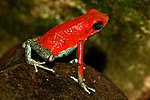Müllerian mimicry is a natural phenomenon in which two or more well-defended species, often foul-tasting and sharing common predators, have come to mimic... 32 KB (3,603 words) - 02:06, 2 April 2024 |
Eyespot can mean: Eyespot (mimicry), a color mark that looks somewhat like an eye Eyespot, a sensory organ of invertebrates; see simple eye in invertebrates... 1 KB (115 words) - 11:53, 25 August 2021 |
 | visible next to the hamsa. Eye of Providence God's eye Evil eye Darśana Eyespot (mimicry) Görece, Menderes Hamsa Namkha Nazar battu Mezuzah Skandola Ta'wiz... 8 KB (904 words) - 20:37, 24 April 2024 |
 | and low-profile life.[citation needed] Anasyrma Azusa yumi Exorcism Eyespot (mimicry) Hama yumi Hamsa Hoko (doll) Jack-o'-lantern Mezuzah Noa-name – Word... 28 KB (3,294 words) - 22:30, 23 April 2024 |
 | lamprey has well-developed eyes, while the hagfish has only primitive eyespots. The ancestors of modern hagfish, thought to be the protovertebrate, were... 66 KB (7,912 words) - 15:28, 23 March 2024 |
In evolutionary biology, mimicry in vertebrates is mimicry by a vertebrate of some model (an animal, not necessarily a vertebrate), deceiving some other... 27 KB (3,406 words) - 04:58, 16 October 2023 |
 | Automimicry (redirect from Browerian mimicry) In zoology, automimicry, Browerian mimicry, or intraspecific mimicry, is a form of mimicry in which the same species of animal is imitated. There are... 17 KB (1,964 words) - 21:50, 2 December 2023 |
 | Animal coloration (category Mimicry) signal their sexual status to other members of the same species; and in mimicry, taking advantage of the warning coloration of another species. Some animals... 48 KB (5,262 words) - 23:25, 27 March 2024 |
 | Saddleback caterpillar (section Mimicry) Thomas John; Sherratt, Thomas N. (2013-08-01). "Defensive posture and eyespots deter avian predators from attacking caterpillar models". Animal Behaviour... 20 KB (2,226 words) - 16:11, 16 March 2024 |
Deception in animals (category Mimicry) (mimesis). In Batesian mimicry, harmless animals may appear to be distasteful or poisonous. In automimicry, animals may have eyespots in less important parts... 54 KB (6,743 words) - 13:34, 23 January 2024 |
 | Aposematism (section Mimicry) Wallace's concept of warning coloration. Aposematism is exploited in Müllerian mimicry, where species with strong defences evolve to resemble one another. By... 52 KB (5,664 words) - 03:12, 26 March 2024 |
 | Predation (section Camouflage and mimicry) and cut up their prey. Other adaptations include stealth and aggressive mimicry that improve hunting efficiency. Predation has a powerful selective effect... 109 KB (11,477 words) - 16:56, 25 April 2024 |
 | Müllerian mimicry. Giant swallowtail caterpillar everting its osmeterium in defence; it is also mimetic, resembling a bird dropping. Eyespots of speckled... 98 KB (9,665 words) - 01:47, 22 April 2024 |
 | Callosamia promethea (section Mimicry) overlap in activity for a few hours in the early evening. The males use mimicry of the poisonous pipevine swallowtail butterfly as a form of protection... 14 KB (1,632 words) - 16:21, 9 January 2024 |
 | Limenitis arthemis (section Batesian mimicry) cosmopolitan genus Limenitis. It has been studied for its evolution of mimicry, and for the several stable hybrid wing patterns within this nominal species;... 32 KB (3,734 words) - 09:24, 7 March 2024 |
Defense in insects (category Mimicry) context of geographic sympatry. Mimicry is divided into two parts, Batesian mimicry and Müllerian mimicry. In Batesian mimicry, an aposematic inedible model... 33 KB (4,141 words) - 10:15, 10 December 2023 |
 | Caudal luring (category Mimicry) Caudal luring is a form of aggressive mimicry characterized by the waving or wriggling of the predator's tail to attract prey. This movement attracts... 14 KB (1,562 words) - 09:24, 18 February 2024 |
 | made the "groundbreaking" discovery that this same gene determines the eyespot pattern in butterfly wings, showing that toolbox genes can change their... 7 KB (865 words) - 21:45, 25 April 2023 |












